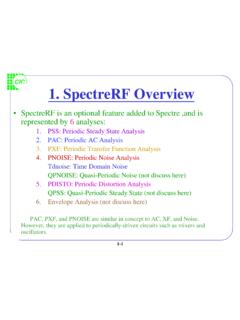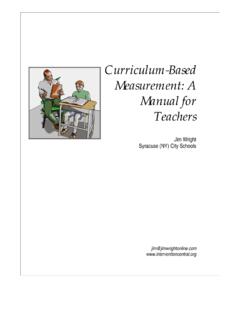Transcription of Food Security Indicators
1 Food Security Indicators Elliot Vhurumuku Senior Regional VAM Advisor WFP East and Central Africa Bureau, Nairobi For the Integrating Nutrition and Food Security Programming for Emergency response workshop 25 to 17 February 2014 Outline Data Required Type of Indicators Analysis of dietary diversity and food frequency Conclusion Broad Definitions? Exists when all people at all times have physical and economic access to sufficient, safe and nutritious food to meet their dietary needs and food preferences for an active and healthy life (FAO 2000). This definition has widely established the four pillars of food Security : availability, accessibility, utilization and stability. Food Security : a person is considered nutrition secure when she or he has a nutritionally adequate diet and the food consumed is biologically utilized such that adequate performance is maintained in growth, resisting or recovering from disease, pregnancy, lactation and physical work.
2 (Frankenberger et al. 1997, ).. Nutrition secure Micro Macro Individual Household National Regional World Food nutrition levels of analysis Combining Food & Nutrition - Modules Indicators for Food Security to collect at HH Demographics for Gender disaggregation Income/Livelihoods - for livelihoods classification Assets for asset score, wealth ranking Expenditure - 30 day recall for food and 6 mnths non food for % share of food Food Consumption and Coping for FCS, CSI, IDDS, HDDS for overall food Security classification Water Sources, Sanitation and Access for food utilization Health diseases and access to facilities; treatment, etc. for utilization Indicators to collect at Individual Level - Nutrition (children, women) Anthropometric Measurements Health Feeding practices Caring practices Dietary diversity and food frequency This type of metric captures the number of different kinds of food or food groups that people eat and the frequency with which they eat them Sometimes involves weighting these groups.
3 The result is a score that represents the diversity of intake, but not necessarily the quantity, though such scores have been shown to be significantly correlated with caloric adequacy measures (IFPRI 2006, Coates et al. 2007). Consumption behaviors These measures capture food Security indirectly, by measuring behaviours related to food consumption. the Coping Strategies Index or CSI, which counts the frequency and severity of behaviors in which people engage when they do not have enough food or enough money to buy food (Maxwell and Caldwell 2008) Types of food Security measurements Dietary diversity and food frequency Consumption Score (FCS); Dietary Diversity Scale (HDDS); on food Consumption behaviors Strategy Index (CSI); Coping Strategy Index (rCSI); iii. Household Food Insecurity and Access Scale (HFIAS); Household Hunger Scale (HHS); measure of food Security (SAFS).
4 CSI and rCSI - capture the element of quantity or sufficiency. HFIAS - captures a mix of sufficiency and psychological factors. HHS - captures the most extreme manifestations of insufficiency. FCS and HDDS - capture quality and diversity (although FCS is calibrated to capture an element of quantity as well. GHI - uses undernourishment, child underweight, and child mortality to calculate hunger Indicators to measure food Security Global Hunger Index (GHI) Definition of the Indicators (Dietary diversity and food frequency) The frequency weighted diet diversity score is a score calculated using the frequency of consumption of different food groups consumed by a household during the 7 days before the survey. An acceptable proxy indicator to measure caloric intake and diet quality at household level, giving an indication of food Security status of the household if combined with other household access Indicators .)
5 It is a composite score based on dietary diversity, food frequency, and relative nutritional importance of different food groups. used primarily by the World Food Programme Food Consumption Score (FCS) Dietary diversity represents the number of different foods or food groups consumed over a given reference period similar to the FCS, but usually with a 24-hour recall period without frequency information or weighted categorical cut-offs It is a proxy measure for HH food access Number of food groups examined: 7-16 Target: individuals (IDDS), household (HDDS), or women (WDDS) widely promoted by the UN Food and Agriculture Organization and USAID (FANTA). Household Dietary Diversity Scale (HDDS) Definition of the Indicators (Dietary diversity and food frequency) measure of food deprivation, is based on a comparison of usual food consumption expressed in terms of dietary energy (kcal) with certain energy requirement norms.
6 Considers mean dietary energy supply as a proxy for food energy consumption. The part of the population with food consumption below the energy requirement norm is considered undernourished ("underfed"). Used by FAO Under- nourishment Estimating the proportion of expenditure on food of the total household income Considers the propensity of people closer to the edge of poverty, spend a greater and greater proportion of their income on food Can also look at the proportion spent on different food groups Spending on food Definition of the Indicators (Consumption behaviours) The CSI measures behaviour: the things that people do when they cannot access enough food. Measures the adjustments HH make in consumption and livelihoods. Coping can be consumption changes; expenditure reduction; income expansion; adopted by WFP/VAM (World Food Programme/Vulnerability Analysis Mapping unit), FAO/FSNAU (UN Food and Agriculture Organization/Food Security and Nutrition Analysis Unit for Somalia), and the Global IPC (Integrated Phase Classification) team, among others.
7 RCSI tend to measure the less-severe coping behaviours rCSI Uses the five most common strategies with standardized weights Coping Strategies Index (CSI/rCSI) The HFIAS was designed to capture household behaviours signifying insufficient quality and quantity, as well as anxiety and uncertainity over household insecure access or food supply. Insufficient quality (includes variety and preferences of the type of food): Insufficient food intake and its physical consequences: Household Food Insecurity and Access Scale (HFIAS) Definition of the Indicators (Consumption behaviors) essentially a behavioural measure. It tends to capture more-severe behaviours; Was there ever no food to eat of any kind in your house because of lack of resources to get food? Did you or any household member go to sleep at night hungry because there was not enough food?
8 Did you or any household member go a whole day and night without eating anything because there was not enough food? The Household Hunger Scale (HHS) These include self-assessments of current food Security status in a recent recall period and the change in livelihood status over a longer period of time highly subjective in nature and perhaps too easy to manipulate in programmatic contexts Self-assessed measure of food Security (SAFS). CSI rCSI HFIAS HHS FCS HDDS SAFS CSI 1 rCSI 1 HFIAS 1 HHS 1 FCS 1 HDDS 1 SAFS 1 * All correlations significant at the p< level Spearman s rho correlations between food Security measures Source: How Do Different Indicators of Household Food Security Compare? Empirical Evidence from Tigray; Daniel Maxwell, Jennifer Coates and Bapu Vaitla, Tuffs University, August 2013 Combine Indicators for Overall Food Security Input Indicators .
9 Domain summary Indicators Console Outcome WFP food insecurity group (1-4) Based on a simple average of summary measures of Current Status and Coping Capacity Summary of Current Status Food consumption score Food energy shortfall Summary of Coping Capacity Economic vulnerability indicator Food expenditure share Poverty line Asset depletion indicator FOOD CONSUMPTION SCORE (FCS) Food groups and weights in FCS and HDDS Food Group Food Items belonging to group Food groups Weight for FCS 1. Cereals and grain: Rice, pasta, bread / cake and / or donuts, sorghum, millet, maize, and Tubers 2 2. Roots and tubers: potato, yam, cassava, sweet potato, taro and / or other tubers 3. Legumes/nut: beans, cowpeas, peanuts, lentils, nut, soy, pigeon pea and / or other nuts 2. Pulses 3 4. Orange vegetables (vegetables rich in Vitamin A): carrot, red pepper, pumpkin, orange sweet potatoes, 3.
10 Vegetables 1 5. Green leafy vegetables:, spinach, broccoli, amaranth and / or other dark green leaves, cassava leaves 6. Other vegetables: onion, tomatoes, cucumber, radishes, green beans, peas, lettuce, etc. 7. Orange fruits (Fruits rich in Vitamin A): mango, papaya, apricot, peach 4. Fruit 1 8. Other Fruits: banana, apple, lemon, tangerine 9. Meat: goat, beef, chicken, pork (meat in large quantities and not as a condiment) 5. Meat and fish 4 10. Liver, kidney, heart and / or other organ meats 11. Fish / Shellfish: fish, including canned tuna, escargot, and / or other seafood (fish in large quantities and not as a condiment) 12. Eggs 13. Milk and other dairy products: fresh milk / sour, yogurt, cheese, other dairy products (Exclude margarine / butter or small amounts of milk for tea / coffee) 6. Milk 4 14. Oil / fat / butter: vegetable oil, palm oil, shea butter, margarine, other fats / oil 7.


















